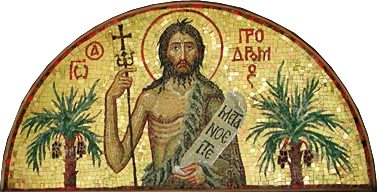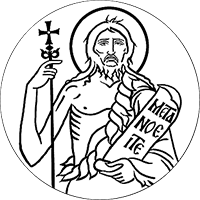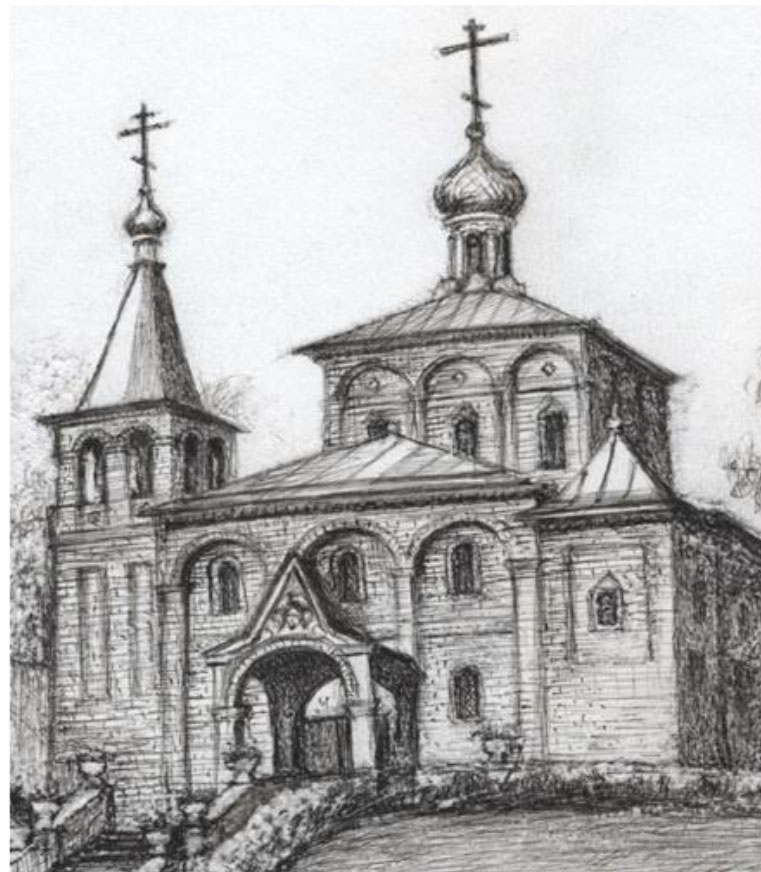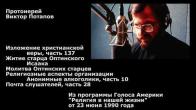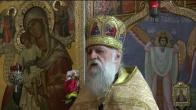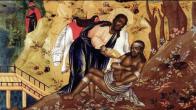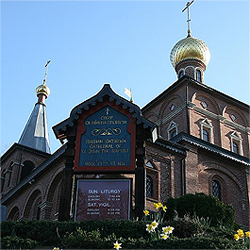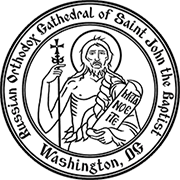You are here
July
- June 18/July 1 -- Icon of Bogolubov, "Bogolubskaya" Uglich, "Bogolubskaya" in Kozlov
- June 20/July 3 -- Modena (Kosino) Icon
- June 22/July 5 -- "Establisher of the House" or "Ekonomissa"
- June 23/July 6 -- Optina-Novo-Diveevo Image of the Mother of God (New York, USA), The Meeting of the Vladimir Icon
- June 26/July 9 -- Tikhvin Icon, Niamets "Moldavian"
- June 29/July 12 -- "Kasperov" Icon, Pryazhevo Icon
- July 7/20 -- "Akhtyrskaya"
- July 8/21 -- "Kazan" Icon
- July 10/23 -- Konevets Icon
- July 16/29 -- Chirsk or Pskov Icon
Icon of Bogoliubov
June 18/July 1
[Translators note: "Bogoliubov" and "Bogoliubsky" can both mean either "beloved of God" or "Godloving."]
This is one of the most ancient wonderworking icons of Russia, painted in the twelfth century at the request of the rightbelieving Prince Andrew Bogoliubsky (commemorated on 4/17 July) in commemoration of an appearance of the Mother of God to him.
In the year 1155, the rightbelieving Prince Andrew, on moving from Vyshgorod to the land of Suzdal, took with him the wonderworking image of the Mother of God painted by the Evangelist Luke (subsequently this icon received the appellation, "Vladimir"). At seven versts [4.6 miles] from Vladimir, the horses carrying the case with the wonderworking icon stopped and could not move from the spot. The rightbelieving Prince Andrew requested the Priest Nikita, who was accompanying him, to perform a moleben before the icon of the Mother of God, and with tears he prayed long before the honored icon. Afterwards, he went to his camp tent, but did not cease from fervent prayer.
At this time, the Most Holy Theotokos appeared to him with a scroll in her right hand and commanded the pious prince to place her image, which was being transferred from Vyshgorod, in Vladimir, and to build a church and a holy monastery on the site of her miraculous appearance. Then she prayerfully lifted up her hands to heaven, receiving the blessing of Christ the Saviour, Who appeared at that time over the earth and blessed her, and the vision vanished.
Fulfilling the command, the rightbelieving Prince Andrew laid the foundation of a stone church in honor of the Nativity of the Most Holy Theotokos at the indicated site, where a monastery was also organized. After that, the holy prince summoned skillful iconographers and requested them to depict the Mother of God just as he had seen her in the appearance: in full figure with a scroll in her right hand and with her face turned toward the Saviour. When the construction of the church was completed, the rightbelieving Prince Andrew transferred into it the image that had been painted and enacted a yearly celebration on the 18th of June (1st of July, new style) in honor of the appearance of the Mother of God , which was confirmed in the Russian Church. The rightbelieving Prince Andrew called the monastery and the town that formed around the monastery "Bogoliubov," because, according to his words, "the Mother of God loved this place," and the prince himself from that time began to be named "Bogoliubov" or "Bogoliubsky."* The wonderworking icon of the Mother of God being transferred from Vyshgorod, was subsequently transferred from the Bogoliubov Monastery to Vladimir, to the Dormition Cathedral, while the icon of the appearance remained in Bogoliubov and was called "Bogoliubov."
The Bogoliubov Image of the Mother of God has been glorified by innumerable wonderworkings, manifesting gracefilled help to the believing Russian people for the space of many centuries. The glory of the wonders and signs performed by the icon prompted believing people in many parts of Russia to resort to painting copies of the honored image, which in time received a wide dissemination and received the gracefilled power of wonderworking.
"Bogoliubskaya" Uglich Icon
18 June/1 July
In pre-Revolutionary Uglich, the grace-filled Icon of the Bogoliubskaya Mother of God was in the church of St. Dimitry the Tsarevitch. The following is contained in the “Uglich Chronicle.”
In 1654, there was a deadly epidemic in Moscow and in other cities. In Uglich, two families, those of priest Gabriel and of Euthemius, who lived near Uglich, suddenly fell ill. The same day, all the members of their families died. The townspeople were terrified. At that time, Afanassy Kustof, on his way to a municipal meeting, was walking along the earthen ramparts. Upon coming to the church of St. Dimitry the Tsarevitch, he saw three boys whom he took to be children of the governor, who lived near that church. One of those youths directed Afanassy to announce to the meeting that God’s anger was coming upon Uglich in the form of a plague, that they should pray to the Lord God and to His Most-pure Mother, that they should call upon the great saints of God: Dimitry the Tsarevitch, Prince Roman, and others for help, and that the Lord would hear their prayers and would turn His ire from the city. Hearing from Afanassy what had been told him by the youth, the citizens immediately went to the church of St. Dimitry. There, they offered prayer services before the Icon of the Mother of God, and the plague came to an end. From that time on, June 18th was designated as the day of celebration of the Bogoliubskaya Icon of the Mother of God.
The "Bogolyubskaya" Icon in Kozlov
18 June / 1 July
This icon became known as a worker of miracles in the year 1771. In that year throughout Russia, and especially in the city of Kozlov, plague was rampant. The city residents did not know what to do, seeing no help from any quarter. On the gate of the home of a certain merchant in Kozlov there hung an icon of the Bogolyubskaya Icon of the Mother of God. It was revealed to a pious priest named John that he was to remove the icon from the gates and carry it in a procession of the cross - after which the plague disappeared. In commemoration of this miracle, the grateful citizens decided to have processions of the cross around the city every year on October 23, the day on which they were miraculously delivered from the plague. The grace-filled icon was placed in a silver and gilt frame decorated with various stones, and was installed in an elegant shrine. A chapel dedicated to the miraculous image was built onto the Protection Cathedral, and later a magnificent cathedral dedicated to the Bogolyubskaya Mother of God was erected.
The Modena (Kosino) Icon of the Mother of God
20 June / 3 July
 This Icon of the Mother of God is called the Kosino Icon because of its arrival in the church of the former village of Kosino, in the Moscow uyezd [district] (now part of the Kosino region of the city of Moscow), to which it was donated by Emperor Peter I.
This Icon of the Mother of God is called the Kosino Icon because of its arrival in the church of the former village of Kosino, in the Moscow uyezd [district] (now part of the Kosino region of the city of Moscow), to which it was donated by Emperor Peter I.
It is also known as the Modena Icon, for, according to tradition, it was brought to Russia from the city of Modena , in Northern Italy, by Count Boris Petrovitch Sheremetev during his travels through Europe in 1717.
It pleased the Most-holy Theotokos to glorify this icon through a multitude of grace-filled signs and marvelous healings. We will point to but some of the most notable of them.
A certain young maiden had suffered for a long time with severe leg pain, and was unable to walk. She often prayed to the Mother of God, entreating her to grant her healing. And lo, in a dream the Theotokos appeared to her, and directed that she pray before the Kosino Icon, and then bathe in the White Lake in Kosino. The sick maiden did everything she was told to do, and was returned to perfect health.
For a long time, a certain peasant couple did not have children. They vowed to go to Kosino and venerate the Miraculous Modena Icon of the Mother of God, and they kept their vow. The Mother of God heard their prayer: the following year, they rejoiced in the birth of their child.
The young son of a certain middle-class resident of Sergiev Posad suffered from scrofula all over his head and face. The sick child’s mother vowed to walk to the village of Kosino to venerate the Miraculous Icon of the Mother of God. As soon as she had made that vow, the sick child got better. She nonetheless kept her vow, and upon arriving at Kosino, had a Moleben served before the Modena Icon of the Mother of God, and then bathed her little boy in the lake. Soon, the child was completely well.
In 1848, cholera raged throughout the settlements and factories around Kosino. Several times, residents of those settlements would take the Miraculous Modena Icon home for communal prayer. Through the intercession of the Mother of God, the incidence of cholera abated, and soon completely ended.
In 1940, after the churches in Kosino were shut down, the Kosino (Modena) Icon of the Mother of God was confiscated by the government, and was transferred to the museum of religion and atheism which was at first located in Moscow , and then moved to Leningrad . After the Great Patriotic War [World War II], the Icon was moved to the Venerable St. Andrei Rublev Museum of Ancient Russian Art, located on the premises of the Savior-Andronicus Monastery in Moscow. Through the mercy of the Queen of Heaven, the second finding of the Kosino (Modena) Miraculous Icon of the Mother of God took place on July 3, 1991.
"Establisher of the House", or "Ekonomissa" Icon
22 June / 5 July
In the 10th Century, the great elder Athanasios established the Athonite monastery known as the "Great Lavra," to which a host of monastics came from all over the world. In a certain year in which the harvest failed, such a famine befell the lavra that all of the monks, one after another, scattered. Even St. Athanasius, an accomplished struggler, was unable to endure the temptation, and with great sorrow decided to abandon the lavra. Carrying his staff, he walked for hours along the road to Karyes, (capital of Mt. Athos - ed.), and being tired, decided to rest. Suddenly a woman wearing a sky-blue shawl came toward him. St Athanasius became frightened, and made the sign of the cross. Where did this woman come from, when entry into Mt. Athos is forbidden to women? The holy elder went towards her. She asked "Where are you going?" St. Athanasius answered "Why do you need to know where I am going? You can see that I am a local monk!". The woman said: "If you are indeed a monk, you should reply as ordinary people do; you should be trusting, direct, and humble." " St. Athanasius told her of his woe. " And you could not endure this? For a daily piece of bread, you are abandoning your monastery, which should be glorious unto generation and generation? Is this in the spirit of monasticism? Where is your faith? Turn around! I will help you: everything will be in abundance, only do not abandon your solitude." St Athanasius asked "Who are you?" She replied "I am the one whom you glorify in your monastery. I am the Mother of your Lord." St. Athanasius said:" I am afraid to believe, for the nets of the devil are many and various. How will you convince me that your words are true?" She directed him: "Strike this stone with your staff, and you will know who speaks with you. Know that from this moment I will always be the Establisher of the House for your lavra. Athanasius struck the stone, and as if struck by lighting and a thunderclap, the stone broke apart, and from the cleft noisily gushed forth a spring of water, and coursed down the hill towards the ocean. St. Athansius turned to throw himself at the feet of the Most Holy Lady, but She had disappeared. He returned to the larva and found that all of the containers in the storerooms were filled with everything needful. In commemoration of this miraculous appearance, the monastery has no steward, but only a helper to the "Ekonomissa.: An Icon of the Mother of God "Ekonomissa" was installed in the Monastery. On this icon, the Theotokos is depicted seated on a throne, in her lap is the Infant Jesus; on the right is St. Michael of Synnada, on the left, St. Athanasius, holding in his hands an image of his lavra. To this day, the life-giving spring continues to flow, and to bring healing. A small church dedicated to the Life-giving spring was build on the site of the apparition of the Mother of God. In this church there is an icon, with an eternal flame burning before it, depicting that miracle.
The Optina-Novo-Diveevo Image of the Vladimir Mother of God
23 June / 6 July
This image is now in the Novo-Diveevo women's monastery, near New York City. It is closely linked to the era of the devastation of Russia and of Russian Orthodoxy.
When, in 1923, the Optina Hermitage was being ravaged, everything in it was being subjected to desecration. Icons were taken from the churches and piled up on the ground to await destruction. Among the women who stood tearfully watching was Schema-nun Evdokia, who managed to take away the Vladimir Icon of the Mother of God. She knew that this image was among those icons which had formerly been in the cell of the famous Optina Elder, Saint Ambrose.
After the Bolsheviks attempted to obliterate Sunday, making of it an ordinary work-day, it became the practice in Kiev to serve very early liturgies, beginning at 5:00 AM, on Sunday. At the direction of Father Michael Edlinsky, a noted spiritual ad-visor to clergy in Kiev, Father Adrian Rimarenko would serve akathists to the Vladimir Mother of God in the Saints Boris and Gleb Church following the very early liturgies.
At Father Michael's request, Father Adrian asked the monastics who had been driven from the Optina Hermitage and who were temporarily in the city of Kozelsk to transfer to Kiev one of the Vladimir icons of the Mother of God which had come from Optina. In response, the very icon of the Vladimir Mother of God which had been rescued from the devastated Optina Hermitage was transferred to Kiev. It should be noted that in those years, when Russia had taken from it the recently elected Most Holy Patriarch Tikhon, the people's reverence for the Vladimir Image of the Mother of God greatly increased. This may stem from the fact that, just as in ancient times, at the time of the selection of Patriarch Tikhon, a lot bearing the name of one of the three candidates who had received the most votes at the 1917 All-Russian Council was drawn before the Miraculous Vladimir Icon of the Mother of God in the Dormition Cathedral within the Kremlin. When Russia found itself bereft of Patriarch Tikhon, all of the prayers and hopes of the orphaned people of Rus', asking for help for nation and Church, turned to the Holy Image of the Vladimir Mother of God.
Subsequently, when most of the churches in Kiev were shuttered, this image of the Vladimir Mother of God, which had been rescued from the destruction of Optina, was preserved in the Rimarenko household. During World War II, the image was taken out of Russia by Archpriest Adrian Rimarenko (later Andrew, Archbishop of Rockland). During the war, the holy image was in Berlin, then in Westerheim and in Weidlingen (Germany), where it preserved Father Adrian and his people: The house in which they were located caught fire during a tank battle between American and German forces. Then, Father Adrian, followed by several dozen Orthodox people with him, squeezed together between the flames, lifted the Image of the Queen of Heaven over his head, dashed forth across the field on which the tank battle was taking place, and crossed between the two opposing forces unharmed.
It was with this icon that Metropolitan Anastassy, the now-reposed First-Hierarch of the Russian Orthodox Church Abroad, blessed Father Adrian and his co-strugglers on their journey to America. Since its passage to the United States, the Holy Image has rested in the women's monastery of Novo-Diveevo, in Spring Valley, New York.
"Parish Life", June 1997
The Meeting of the Vladimir Icon of the Mother of God
June 23/ July 6; August 26 /September 8
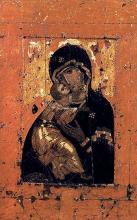 More than once, the Vladimir Icon of the Mother of God has miraculously saved Russian forces from seemingly certain and inescapable defeat. In 1395 Tamerlane and his Tatar forces entered the Russian land and moved against Moscow, with forces possessing incomparable power and experience and outnumbering the Russian armies by several times. Moscow's only remaining hope rested in fortune and God's help. Thus, Great Prince Vasily Dimitrievitch of Moscow sent to Vladimir for the Miraculous Icon. Over the course of the Vladimir Icon's ten-day journey from Vladimir to Moscow, people stood on their knees along the road and implored "O Mother of God, save the Russian land."
More than once, the Vladimir Icon of the Mother of God has miraculously saved Russian forces from seemingly certain and inescapable defeat. In 1395 Tamerlane and his Tatar forces entered the Russian land and moved against Moscow, with forces possessing incomparable power and experience and outnumbering the Russian armies by several times. Moscow's only remaining hope rested in fortune and God's help. Thus, Great Prince Vasily Dimitrievitch of Moscow sent to Vladimir for the Miraculous Icon. Over the course of the Vladimir Icon's ten-day journey from Vladimir to Moscow, people stood on their knees along the road and implored "O Mother of God, save the Russian land."
According to tradition, this wonderworking image belongs to those three "basic" images, which are, as it were, contemporaries of the Mother of God herself.
In the fifth century, this icon was transferred from Jerusalem to Constantinople, where the Blachernae church was built for it. In the year 1383, seventy years before the taking of Constantinople by the Turks, the icon disappeared, and in a brightly beaming light it appeared over Lake Ladoga within the boundaries of Novgorod the Great.
The 14th-15th centuries are the critical epoch of Russian consciousness. While not rejecting the principles of Greek Orthodoxy and in no way exalting itself, Russian Orthodoxy is formed.
At this time, two enormous events occur, which shake the trust of Russian people in the Greeks: the Florentine Unia with the Catholics and the taking of Constantinople by the Turks. The idea of Moscow, as the third Rome, is born; stories arise about the flight of holy objects from the disgraced centers of ancient Greek piety. The appearance in Russia of a great Byzantine holy object, the Tikhvin Icon of the Mother of God, which received its appellation from the place chosen by Her for its appearance in Russia, also dates to this period.
A most interesting story, very characteristic of that time, concerning the miraculous voyage of Saint Anthony the Roman on a rock from Rome to Novgorod the Great, who brought with him various relics of saints of the ancient Church, dates to that same time.
"In I. S. Ostroukhov's collection of icons", we read in Prince Trubetskoi, "is a depiction of this miraculous voyage… Over the holy refugee from Rome, who is sailing along the Volkov, the golden domes of Novgorodian Russian churches gleam: in them is the goal of his wandering and the sole worthy place of abode for the holy objects entrusted to him by God" (Prince E. N. Trubetskoi, "Speculations in Colors", page 124).
In 16131614, the Swedish army, having captured Novgorod, more than once attempted to annihilate the monastery in which the Tikhvin Icon was located; but through the succor of the Mother of God, the monastery was saved. Thus, once, in sight of the approaching Swedish army, the monks decided to flee from the monastery, taking the wonderworking icon with them; but they could not move it from the spot. This miracle stopped the fainthearted, and they remained in the monastery, trusting in the defense of the Mother of God. The defenders of the monastery, who were insignificant in number, successfully repulsed the attacks of the adversary's forces, which far surpassed their own. A numerous host of Russians coming from Moscow, a kind of heavenly army, arose before the attacking Swedes, and they turned to flight. After the miraculous victory over the Swedes, royal emissaries arrived at the monastery. Having made a copy of the wonderworking icon, they set out for the village of Stolbovo, at fifty versts [thirtythree miles] from Tikhvin, where peace was concluded with the Swedes on the 10th of February 1617.
The main surety of the peace on the Russian side was the copy of the wonderworking icon that had been brought. Subsequently, this copy was brought to Moscow and placed in the Dormition Cathedral, and then, at the request of the Novgorodians, the participants in the war with the Swedes, it was sent to Novgorod and placed in the Cathedral of the Holy Wisdom.
At the present time, the holy image of the Tikhvin Mother of God is located in Chicago, after it was brought to the USA from Riga. The holy image arrived in Riga during the German occupation. Till then, the image was located for a long time in a secret place, where it was hidden from the Bolsheviks.
It is impossible not to pay attention to the fact that this image departed beyond the borders of Russia with the second emigration, just as the KurskRoot Icon did with the first emigration.
In the iconographic sense, it is a Hodigitria. The Tikhvin Icon differs from the Smolensk Icon of the Mother of God in the slightly inclined position of the Mother of God toward the Infant, Who is depicted on the left side of the image. The hand of the Mother of God is raised toward her breast as a sign of silent worship of her Son.
(Basic information from the book by Prot. Alexander Kiselev, "Wonderworking Icons of the Mother of God in Russian History", New York, 1976.)
The Niamets "Moldavian" Icon
26 June/9 July
We know that in 1399, the Greek Emperor Andronicus Palaeologue, son of Emannuel, gave the miraculous icon which is in the Niamets monastery in Moldavia, with his blessing to the Moldavian ruler Governor (Voyevod) Alexander.
A Moldavian prince gave Count Tchertkoff an exact copy of the miraculous Niamets-Moldavian icon of the mother of God; neither the prince’s name, nor the period of his reign are known to us. In 1846, Ivan Dimitrievich Tchertkoff, landlord of the settlement of Mikhailovka, sent this icon as a blessing to the peasants of Mikhailovka settlement, Bogucharsk District in the Diocese of Voronezh. On the eve of June 24th, the icon was brought in procession to Mikhailovka, where it was installed in the Holy Nativity Church. The icon is an ancient image, artfully written on canvas. It has a silver and gilded riza. At its base, there is an inscription in Moldavian. On the reverse are inscriptions in gold letters, stating: a) “The image, which belonged to my mother (Countess Tchertkova), Avdotya Stepanovna Tchertkova, born in Tevyashevo, and which stood behind the Altar table in our house church in Voronezh, which is now the gentry club.” b) [the first inscription in Moldavian] “a faithful rendering of the miraculous icon of the most holy mother of God, which is in the holy monastery called Niamets (Niamtsula) in the Moldavian land, sent by the most pious Emperor of Constantinople Andronicus Palaeologue to Governor Alexander of the Moldavian land in 6907 (1399).”; and c) “as a sign of blessing to my peasants I donate this to the church of the settelement of Mikhailovka.”
A considerable number of miraculous signs have been manifested through the Niamets-Moldavian icon of the mother of God.
"Kasperov" Icon
29 June/12 July, 1/14 October
and on Wednesday of the Bright Week
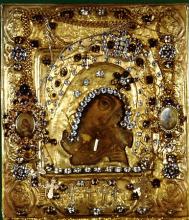 At the close of the 16th Century, a Serb took the "Kasperov" Icon of the Mother of God from Transylvania to his new home in the Olviopolsk district in Kherson province. The Icon was handed down in blessing from parent to child, and in 1809 came into the possession of a certain Mrs. Kasperov, who lived in the village of Novo-Ivanovo, situated on the right bank of the Dniepr River. It so happened that in February 1840, Mrs. Kasperov was praying long into the night over her many sorrows. During those prayers she saw that the ancient Icon, which was so darkened with age that it was difficult to make out its features, had suddenly renovated itself, and that the faces of the Theotokos and the Savior had become clear and bright; they have remained so to this day. Soon thereafter, many instances of healings and other grace-filled miracles coming from the Icon revealed its wonderful power, and brought it renown. Following a study of the many miracles stemming from the Icon, the Icon was acknowledged to be miraculous. From everywhere, those who were suffering, those beset by illnesses, those in need of divine assistance, were drawn to the Icon.
At the close of the 16th Century, a Serb took the "Kasperov" Icon of the Mother of God from Transylvania to his new home in the Olviopolsk district in Kherson province. The Icon was handed down in blessing from parent to child, and in 1809 came into the possession of a certain Mrs. Kasperov, who lived in the village of Novo-Ivanovo, situated on the right bank of the Dniepr River. It so happened that in February 1840, Mrs. Kasperov was praying long into the night over her many sorrows. During those prayers she saw that the ancient Icon, which was so darkened with age that it was difficult to make out its features, had suddenly renovated itself, and that the faces of the Theotokos and the Savior had become clear and bright; they have remained so to this day. Soon thereafter, many instances of healings and other grace-filled miracles coming from the Icon revealed its wonderful power, and brought it renown. Following a study of the many miracles stemming from the Icon, the Icon was acknowledged to be miraculous. From everywhere, those who were suffering, those beset by illnesses, those in need of divine assistance, were drawn to the Icon.
In 1852 the residents of Kherson requested permission to have an annual Procession of the Cross with the Icon on the Feast of the Lord's Ascension. During the war years 1853-1855, such a Procession of the Cross with the Icon took place in Odessa because of the hostilities besetting that city and the city remained unharmed. This was taken as a sign of the Mother of God's special protection. It was then decided "to make this event ever-memorable unto instruction to future generations, and to make October 1 a Holy Feast-day." Each year, the Icon is taken in procession from Kasperovka to Odessa, where it remains from October 1 until the fourth day of Pascha. From the Feast of the Ascension until July 29 it is in Kherson, and from July 1 until August 1, in Nikolaev. In each of these towns, the Akathist to the Most-holy Theotokos is sung before the Miraculous Icon each Friday.
The "Kasperov" Icon is an ancient image written in oils on canvas and affixed to a board. Flanking the central image on the Icon are St. John the Baptist the Holy Martyr Tatiana. The Icon is 30.8 cm in height and 26.4 cm in width. The Mother of God is depicted holding the Pre-eternal Infant on her left arm. In His right hand, He holds a scroll. Framing the Icon is a gold riza of fine craftsmanship, decorated with pearls, rough and cut diamonds, rubies, and emeralds.
THE PRYAZHEVO ICON
29 June / 12 July
This Icon of the Theotokos dates to the 17th or early 18th Century, but no record as to where it first appeared has survived. While it is true that no historical documents mention it, references in old church books in the town of Pryazhevo (from whence the Icon got its name), attest to its antiquity. It is in the church in Pryazhevo, a village not far from the town of Zhitomir, that the Icon is to this day.
The absence of documents regarding the Pryazhevo village church is explained by the fact that in the 18th Century, both the village church and the Miraculous Icon belonged to the Uniates; it was only on October 18, 1794, that at the direction of the Russian government, it was returned to the Orthodox. Before the destruction of the Unia, some Catholic priest came to Pryazhevo and, taking the Icon of the Mother of God, attempted to take it away, but was unable to do so. When he was a little over 4 km from Pryazhevo, his horses suddenly stopped. Nothing the people tried could get them to move from the spot. Inadvertently glancing at the Icon of the Mother of God, the priest noticed on her face some kind of moisture, resembling tears. He realized that the Queen of Heaven did not want her Icon to be taken away from the village of Pryazhevo. He immediately ordered the coachman to return to Pryazhevo; upon their arrival, he returned the Icon to its place in the Pryazhevo church.
As the church was poor, at first the Icon of the Mother of God was decorated with a copper riza. Learning of this, in 1864 Empress Maria Alexandrovna sent a silver riza encrusted with precious stones to be placed on the Pryazhevo Icon. On May 24, 1874 the Miraculous Icon was taken from the High Place, where it had previously rested, and installed above the Royal Doors in the Iconostasis; an Icon of Jesus Christ praying in the garden of Gethsemane was put in the High Place.
At the time of the appearance of this Icon of the Mother of God, it became the established custom to carry it in a Procession of the Cross to the Cathedral in Zhitomir; later, when the Pryazhevo church fell into the hands of the Uniates, this practice came to an end. When the Pryazhevo Icon returned to the Orthodox, an appeal was made to the Holy Synod to re-establish the ancient pious tradition. In response, the Synod issued an ukaz permitting an annual Procession of the Cross with the Miraculous Icon of Pryazhevo to the Zhitomir Cathedral. By established tradition, the Icon remains in Zhitomir from June through August.
A fountain of healing help and comfort has not ceased to pour forth from the Pryazhevo Icon, and now pours out on those who run to it with faith and hope in the Heavenly Queen’s intercession before God.
In the town of Akhtyrka (Kharkov province), there had long been a parish church dedicated to the Protection of the Most-pure Theotokos. In 1739, a pious and virtuous priest named Fr. Daniel Vasiliev was serving at that church. Once, at the approach of the harvest, he was mowing the grass in his garden. He had hardly swung the scythe twice before he saw in the grass an icon of the Mother of God, praying before the crucified Lord Jesus Christ, and shining with an indescribable light. In pious awe, Fr. Daniel signed himself with the sign of the Cross, and began to read prayers to the Most-holy Theotokos. After fervently praying and after making three great prostrations before the image of the Most Holy Theotokos, he carried it into his house and placed it in an appropriate place. This icon remained in the priest’s home for three years. Members of his household noticed that some inexplicable sensation of fear made it impossible to spend the night in the room in which the icon rested. Three years later, on the feast of the Protection, the priest entered the room and, just as before, was unexpectedly stunned by a bright light emanating from the icon. This apparition was repeated many times, but he would pray and tell no one about it.
Once while dozing, he dreamed of the Mother of God, and heard her direct that he clean the dust from the icon which he had discovered, wash the icon with clean water, and then drape a cover over the icon. The priest awoke and hurried to wipe the dust from the icon and to wash it with clean water. Intending to later pour the water into the river, he put the water into a container. He again fell asleep, and in a dream saw himself carrying that container of water towards the river; along the way he saw the Most-holy Theotokos, who said to him: “Go home and keep this water; it will heal all those who suffer from the fever.” The priest had a daughter who for a long time had suffered with fever. Awaking, he gave her some of the water to drink, and she immediately was healed. Thereafter, all those who suffered with fever would run to the Most-holy Theotokos, and as soon as they drank of the water from her icon, would be healed.
When the priest noticed that little wounds had begun to appear in the painted surface of the icon, he asked an iconographer friend to restore the icon. The iconographer took the holy icon home, and put it in a fitting place. Two nights later, when he had decided to to begin work on the icon, he suddenly heard a voice coming from the icon, saying” Get up, it is time for you to take the icon back to the place from which you had taken it. You cannot improve it.” In terror, the iconographer arose, reverently took the icon, and at dawn took it to the priest and told him of the voice which he had heard. Recognizing the miraculous signs coming from the icon, the priest decided that it was best to take it to his parish church. There the icon shone forth with the power of working miracles.
John, the iconographer who had been given the icon for restoration, had a child who suffered from the fever. Learning of the miraculous effect of the water from the Akhtyra icon of the Theotokos, he washed the icon, and as soon as he had given the sick child a drink of that water, his sickness left him.
Many miracles were wrought before the miraculous icon according to the faith of those who ran to its grace-filled power. One of these is especially noteworthy because of the veracity of its historical documentation. Elizabeth, the ill wife of General Vedel, came to Akhtyrka and fervently prayed before the icon of the Theotokos that she might be healed. The next night she saw the Mother of God in a dream, and heard her direction: “You ask in vain for healing from illness. You do not need that. You will soon depart from life. Give all of your possessions to the churches and to the poor. That sacrifice will be for the good of your soul.” The ill one answered, “O Mother of God, I have children, and if I give away my estate, my children will be left in extreme poverty and need.” In response, the Mother of God said, “Do not be concerned for your children. I will be their eternal protectress.” Then, the Mother of God became invisible. The ill woman, waking from her sleep, called summoned her spiritual father, told him of the apparition, and five days later, as told to her by the Mother of God, peacefully reposed. Empress Catherine II, learning of the miraculous protection promised to the children of the late Mrs. Vedel, took her two daughters into her care, and later gave them in marriage, one to Count Palen, the other to Count Chernishev.
This miraculous icon used to be in the cathedral church of the town of Akhtyrka, Kharkov province.
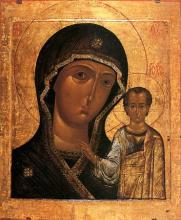 In 1689, a moleben was being sung in the Ascension Monastery in Moscow. Someone forgot to extinguish the candle before leaving the church. The candle fell, and the flames burned up the analogion upon which the Kazan Icon lay. Yet, neither the Icon itself, which was written on canvas, nor the cloth upon which the icon rested suffered any damage.
In 1689, a moleben was being sung in the Ascension Monastery in Moscow. Someone forgot to extinguish the candle before leaving the church. The candle fell, and the flames burned up the analogion upon which the Kazan Icon lay. Yet, neither the Icon itself, which was written on canvas, nor the cloth upon which the icon rested suffered any damage.
In a fire in the Kremlin on June 19, 1701, the Royal Palace and the Ascension Monastery were consumed by flames. During that fire, Schema-nun Ioanna, daughter of Prince Baratynsky, entered his tomb, where the Kazan Icon of the Theotokos hung. She prayed before it: "O Most-holy Theotokos, thou who didst thyself save thine Image from harm, save also me, thine unworthy servant!" After fervently praying, she left the monastery. The Icon remained behind. The liturgical vessels and icons were removed from the Cathedral Church of the Ascension, and taken beyond the Kremlin, to the Church of the Holy Trinity on the moat. In the course of an inventory taken to see whether everything had been removed from the church, they found the Kazan Icon among the others. All were at a loss to say how that Icon got there, as no one had taken it from the church. After the fire, as they were just beginning to return things to the church, and before they even thought about bringing in the Kazan Icon, they found it in its usual place.
Many miraculous healings, which took place before that Holy Icon, are among the miracles described in the annals of the Ascension Monastery.
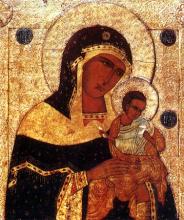 Konevets Icon of TheotokosIn 1393, Venerable St. Arseny established the Monastery of the Nativity of the Mother of God on the uninhabited island of Konevets. The entire history of the Monastery was blessed by the invisible presence of the Most-immaculate Mother of God, who glorified her miraculous icon here in Konevets. It was from the name of the island that the Icon took its name.
Konevets Icon of TheotokosIn 1393, Venerable St. Arseny established the Monastery of the Nativity of the Mother of God on the uninhabited island of Konevets. The entire history of the Monastery was blessed by the invisible presence of the Most-immaculate Mother of God, who glorified her miraculous icon here in Konevets. It was from the name of the island that the Icon took its name.
St. Arseny, who was tonsured a monk at the Lisogorsk Monastery in Novgorod, spent three years in ascetic labors on Holy Mt. Athos. Abbot John Zidon gave him a Greek icon in blessing him for his return to Rus’. On one side of the Icon is a depiction of the Mother of God with the Divine Infant Jesus in her arms, holding in His hand two baby doves. On the reverse is a Greek icon of the Savior-Not-Made-By-Hands, on a dark blue background. On Mt. Athos, the Icon was known as the “Akathist” Icon.
Upon arriving in Novgorod and getting episcopal blessing to establish a monastery to the Most-holy Theotokos in Novgorod, St. Arseny at first went to Valaamo. However, finding a well-populated monastery there, the holy monk went by boat along the Ladoga River in search of a desert island suitable for monastic life.
By the will of God and the attention of the Most-pure Sovereign Lady, the boat was driven by the wind to Konevets. Taking this as a sign from God, St. Arseny landed at the island, climbed a hill now known as the Holy Hill, and planted there a wooden Cross.
Such was the beginning of the Konevets Monastery, chosen by the Theotokos herself to be the place of habitation of her Holy Icon.
The Most-holy Theotokos helped St. Arseny to establish the Monastery. During the Saint’s extended absence, The Queen of Heaven appeared thrice to monastic Elder Joachim on Konevets, to strengthen the monastic brethren, who were on the verge of leaving.
Following the repose of the monastery’s founder, monastic life continued peacefully under the Heavenly protection of our Most-blessed and Glorious Lady. However, in the 16th Century, the Swedes, who had recently become Lutherans, began to propagate their faith in the Karelian lands. In 1577 they sought to destroy the Konevets Monastery, the pillar of Orthodoxy; however, in answer to the monks’ prayers to their Heavenly Helper, a powerful wind blew up and broke the ice surrounding the monastery, preventing the foe from crossing over to the island. During this difficult period, in 1576, there was a miraculous sign from the Konevets icon to console the monastics. The miracle is annually commemorated on 10/23 July, but with the passage of time, we no longer know the exact nature of the miracle that took place.
In 1610, Konevets, together with the other lands of North-Western Rus’, fell to the Swedes. The brotherhood of the Konevets Monastery was forced to move to the Derevianits Monastery in Novgorod. The monks took the Miraculous Icon with them, and it remained in Derevianits for 189 years, until 1799.
After defeating the Swedes, Emperor Peter I ordered in 1718 that the Konevets Monastery be restored. However, it was only in 1798 that, with the blessing of Metropolitan Gabriel of St. Petersburg, Bartholomew, a builder from Kamenets, received permission from the Holy Synod to return the Holy Icon to Konevets. A copy of the Icon was made at the Derevianits Monastery, and was placed in the frame that had previously housed the original icon. In St. Petersburg, through the efforts of some benefactors, a rich silver gilt riza was fashioned for the Holy Icon. On June 3, 1799, Abbot Bartholomew departed with the Icon for St. Petersburg, where the Icon remained until September of the same year. When the riza was completed, Abbot Bartholomew returned with the Icon to the Monastery. There it was met with great solemnity by the monastic brethren. This happened on September 3, 1799.
The Konevets Icon of the Mother of God Icon had already gained renown as a source of wonder-working power while St. Arseny was still alive, and the occurrence of miracles from the Icon did not cease after his repose. Miraculous healings by the Holy Icon happened throughout the 19th Century, and continued into the 20th (the latest recorded in 1912.)
In 1917 Konevets was part of Finland, and during the war years of 1939-1940 the Finnish authorities evacuated the monks from the island. The monks took the Miraculous Konevets Icon with them. To this day, the Icon remains in the New Valaamo Monastery in Finland, and on Konevets, one can see only a recently-made copy.
The Chirsk, or Pskov, Icon
16/29 July
Originally this Icon was in a church in the village of Chirsk, in the Diocese of Pskov. In 1420, with an epidemic raging in Pskov, tears began to flow from both eyes of the Chirsk Icon of the Mother of God. Learning of this sign, Prince Fyodor Alexandrovitch of Pskov sent clergy to bring the Miraculous Image to Pskov. At the meeting of the Icon, there was a procession of the Cross, attended by a multitude of people, including the prince. Everyone piously offered up prayers. The people of Pskov carried the Icon into the city and placed it in the Cathedral Church of the Holy Trinity. July 16th was instituted as the Icon’s Feast Day, in commemoration both of the epidemic’s cessation, and of the many miracles which were shown forth through the Icon. After its transfer to Pskov, the Chirsk Icon came to be known as the Pskov Icon. In 1470, the Church of the Sign was erected at the Staro-Znamenskiy [Ancient Sign] Women’s Monastery, in commemoration of the Icon’s translation to Pskov.
PARISH LIFE
RECENT VIDEOS
Address of our Cathedral
Subscribe to our mailing list
While all the materials on this site are copyrighted, you may use them freely as long as you treat them
with respect and provide attribution on the Russian Orthodox Cathedral of St.John the Baptist of Washington DC.
